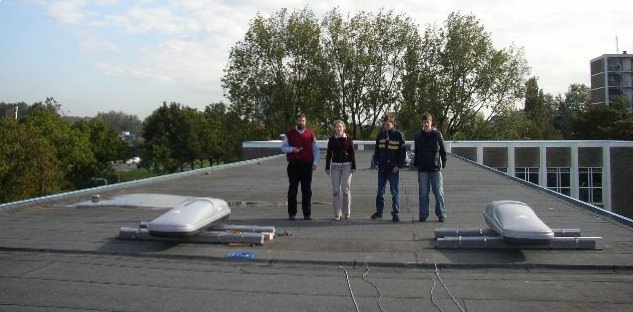|
Europhysics News (2005) Vol. 36 No. 1 HiSPARC Pierre van Baal (Leiden University) and Jan-Willem van Holten (NIKHEF, Amsterdam), for the HiSPARC collaboration. There is no better way to achieve this than by involving students in research as early as possible. This is the main aim of the High-School Project on Astrophyics Research with Cosmics (HiSPARC) [1]. Following the example set by others elsewhere [2] and initiated in the Netherlands by Charles Timmermans and Sijbrand de Jong in Nijmegen [3], HiSPARC members have built a network of cosmic-ray detectors based on high-school infrastructure, involving students and teachers in an essential way by making them collaborators in the research. A cosmic ray is observed through the shower of secondary particles it creates when entering the atmosphere of the earth. The larger the area the shower covers when reaching the surface, the larger the primary energy of the cosmic particle. Such showers are reconstructed through coincidence measurements between detectors. These detectors are placed on the roof of the participating schools, creating city-centered regional clusters of detectors. The average distance between the schools guarantees a sufficient number of coincidences, allowing students to get meaningful measurements within a period of a few months. Internet connections, available at all schools in the Netherlands, allow the transfer and central collection of data. Subsequently data and suitable analysis tools are made available to all participants. At the same time, the involvement of enough schools provides an opportunity to hunt for Ultra-High Energy Cosmic Rays (UHECRs). In this way the project can contribute to solving the puzzles surrounding the origin and nature of these cosmic particles with energies above 1020 eV. At the initiative of Bob van Eijk,Henk-Jan Bulten and the present authors the project is now run at a national level. It is co-ordinated by NIKHEF, the Dutch research institute for subatomic physics in Amsterdam. The importance of the project was recognized by the Foundation for Fundamental Research of Matter (FOM), a national physics funding agency, which has appointed Ilka Tanczos as full-time national project co-ordinator. Recently HiSPARC also received a strong boost when it was awarded the prestigious european 2004 Altran Prize for Innovation [4]. The Altran Foundation will provide a full year of technical support and assist in the development of a professional organization. Nationwide the project now has five active detector clusters in Amsterdam, Groningen, Leiden, Nijmegen and Utrecht.
An interesting aspect of the set-up in Leiden is that the HiSPARC detector recently installed at the university is also intended to function as a veto for excitations in the miniGRAIL gravitational wave detector [5] simultaneous with the arrival of a cosmic air shower. Clearly HiSPARC is a near unlimited source of research projects, which are a compulsory part of high-school science education in the Netherlands. HiSPARC is still young, but it has already built up considerable momentum. It should run for at least ten years, and a considerable effort is going into the development of educational packages, mostly by teachers of the participating schools. Several of them receive funding to allow their schools to temporarily free them for work on HiSPARC, typically for one day per week.All this helps in fulfilling the goals of science education: stimulate teachers and students to enjoy science in a active way, and bring scientific thinking and scientific culture into the schools. References [2] The NALTA webpage: csr.phys.ualberta.ca/nalta/ [3] The Nijmegen HiSPARC webpage: www.hef.kun.nl/nahsa/ [4] The Altran Foundation webpage: fonda.netarchitects-europe.com/ [5] Poster presented at the 19th Cosmic Ray Symposium in Florence: www.lorentz.leidenuniv.nl/research/vanbaal/DECEASED/HiSPARC-MiniGRAIL.pdf (2.3 Mb); The MiniGRAIL wepage: www.minigrail.nl
|


